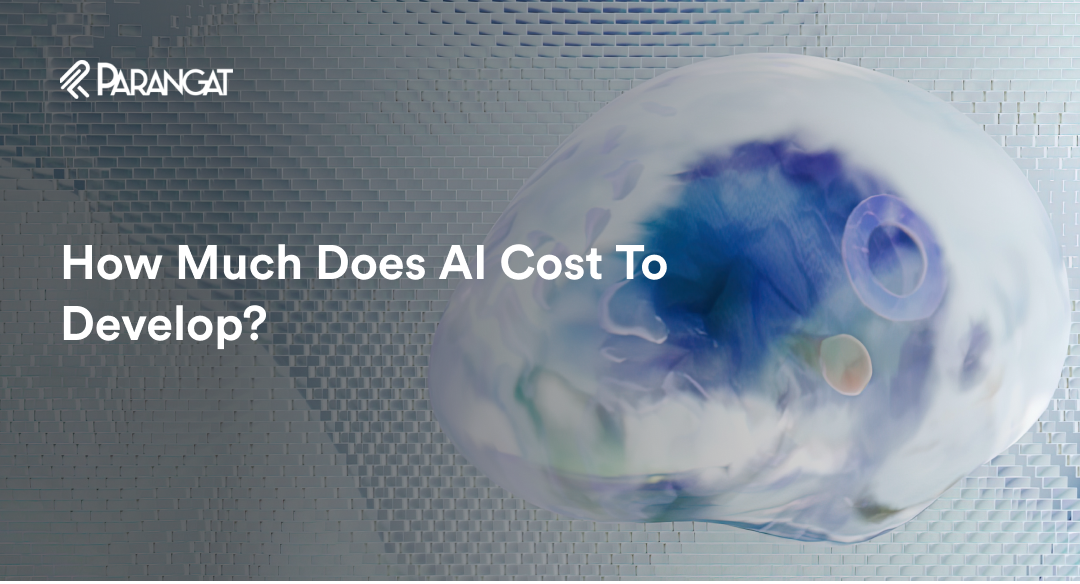Did you know that the value of the AI market is expected to grow to almost 2 trillion USD by 2030? It’s no surprise considering how rapidly AI is expanding and transforming industries.
But have you ever wondered about the cost of AI development?
Understanding the AI cost in development is crucial whether you’re a business or an individual looking to leverage this powerful technology. It can help in resource allocation and budgeting. It will also enable you to assess AI initiatives’ feasibility and return on investment.
In this article, you’ll find various factors that influence AI cost. So, keep reading to make an informed decision.
What is an AI?
Artificial Intelligence refers to developing intelligent systems capable of performing tasks that typically require human intelligence. These systems use advanced algorithms and techniques to analyze data and solve complex problems. AI contains various technologies such as machine learning, natural language processing, and more.

Factors Behind Affecting the Cost of AI
Here are certain factors affecting cost of AI development:
1. Type of AI:
The type of AI solution being developed significantly influences the cost. More sophisticated AI models generally require additional resources and expertise, thereby increasing the cost. Here are some common types of AI and their impact on price:
- Rule-Based Systems: Rule-based systems follow predefined rules and logic to make decisions or perform tasks. These systems are relatively simpler and less expensive to develop than other AI types. They require a clear set of rules and guidelines to be defined, which can be done with less effort and resources.
- Machine Learning Models: Machine learning involves training AI models on data to learn patterns and make predictions or decisions. Developing machine learning models requires expertise in data analysis and model training. The cost can vary based on factors like the complexity of the model, the amount of data available, and the need for specialized algorithms.
- Deep Learning Networks: Deep learning is a subset of machine learning that uses artificial neural networks with multiple layers to process complex data. Deep learning models are highly refined. They require significant computational power and extensive data for training. Developing deep learning networks can be more expensive due to the need for advanced hardware and specialized expertise.
- Natural Language Processing (NLP): NLP focuses on enabling computers to understand and process human language. Developing NLP systems involves language parsing, sentiment analysis, and generation. The cost depends on the language processing requirements’ complexity and the desired accuracy level.
2. Complexity of the Solution:
The complexity refers to the training data and processing power needed to solve a problem. Assessing the complexity upfront can help set realistic expectations and budgets for the development process.
Here are some factors that can affect the complexity of AI development:
- Algorithm Complexity: Developing AI systems with complex algorithms, such as those used in deep learning or advanced machine learning models, requires specialized expertise. These algorithms may involve elaborate mathematical computations and complex optimization techniques. Implementing such algorithms adds complexity and is a big factor of AI cost increment.
- Integration with Multiple Systems: Integrating AI systems with existing software applications requires seamless communication and data exchange between components. The more the number of systems or applications involved, the higher the complexity and development cost.
- Real-Time Processing or Decision-Making: Some AI solutions must process and analyze data in real-time to make instant decisions or provide real-time responses. Implementing real-time capabilities adds complexity to the system architecture. It may require additional resources, infrastructure, and expertise, thus impacting the cost.
- User Interface and User Experience: If the AI solution requires a user interface or user experience design, the complexity of designing an intuitive and user-friendly interface can affect the development cost. Creating visually appealing and interactive interfaces with smooth user interactions may require additional time and resources.
3. Amount of Data:
AI systems thrive on large volumes of data to learn and improve their performance. Acquiring, cleaning, and organizing the necessary data can involve significant costs, especially if the data is scarce or needs to be collected from various sources.
Here are some references related to the amount of data:
- Data Quantity: AI systems require substantial data to train and learn from. However, acquiring large volumes of data can involve costs, especially if the data needs to be obtained from external sources or requires extensive data collection efforts.
- Data Quality: The data quality used for AI development is crucial. High-quality data accurately representing the problem domain leads to better performance in AI. Ensuring data quality may require data cleaning, preprocessing, and validation, which can add to the development cost.
- Data Diversity: Having diverse data that covers a wide range of scenarios and variations can enhance the AI system’s ability to handle different situations. However, collecting or curating various datasets may involve additional costs, mainly if the desired data is not readily available.
- Data Accessibility: The ease of accessing the required data can impact the development cost. Suppose the data is readily available in a well-organized format. In that case, the cost of acquiring and processing it may be lower. However, If the data is scattered across various sources or needs to be extracted from different formats, it will need extra effort, thus adding to costs.
- Data Privacy and Security: Ensuring data privacy and security becomes crucial when working with sensitive or personal data. Executing appropriate measures to protect data privacy can add to the development expenditure.
4. Expert Services:
AI development often requires specialized expertise. While expert services may increase the cost, they provide valuable knowledge and skills that can significantly impact the success of the AI project.
Here are some key points related to expert services and their impact on cost:
- AI Professionals: Skilled AI professionals possess the knowledge and expertise to develop AI systems. Hiring experienced AI professionals can add to the development cost as their expertise comes at a premium. Their skills in algorithm development, data analysis, model training, and system optimization contribute to the overall quality and performance of the AI solution.
- AI Development Companies: Partnering with AI development companies can provide access to a team of experts specializing in AI development. These companies have experience developing AI solutions across various industries and can offer valuable insights and guidance throughout the project. Moreover, they have extensive knowledge of optimization techniques and can fine-tune the AI system.
- Quality Assurance and Testing: Ensuring the quality and reliability of AI systems is crucial. Expert services for quality assurance and testing can help identify and resolve issues. They can also validate results and ensure the system meets the desired objectives. These services contribute to the overall cost but help deliver a robust and reliable AI solution.
5. Training and Maintenance:
Training and Maintenance are essential aspects of AI development that require ongoing effort and investment. Ignoring training and maintenance can lead to decreased efficiency or even system failure. Here are some key points related to training and maintenance and their impact on the cost
- Regular Updates: AI models must be regularly updated to incorporate new data, algorithms, or features. Updating the model helps improve its performance and adaptability to changing conditions. Updating the AI system may require additional development time and resources, contributing to the overall cost.
- Monitoring and Performance Evaluation: Continuous monitoring of the AI system’s performance is necessary to identify any issues or deviations. Regular evaluation helps ensure the system functions optimally and meets the desired objectives. Monitoring and evaluation activities may involve data analysis, performance metrics assessment, and fine-tuning, all of which incur costs.
- Troubleshooting and Bug Fixing: Like any software system, AI solutions may encounter issues or bugs that must be addressed. Troubleshooting and bug fixing involve identifying and resolving system malfunctions or errors. These activities require skilled professionals and may involve minor or significant costs depending on the complexity of the problem.
- Data Management: Managing and updating the data for AI training is required to maintain the system’s accuracy and relevance. This includes data collection, cleaning, labeling, and organizing. Data management activities can contribute to the ongoing cost of maintaining the AI system.
Costs Associated with AI:
Implementing AI includes various expenses that need to be considered, some of them are as follows:
1. Hardware Costs:
Hardware costs in AI development refer to the expenses associated with the physical infrastructure required to support AI systems. These costs can include:
-
- High-Performance Computing Devices
- Specialized Hardware Accelerators
- Storage Solutions
- Networking Infrastructure
- Cloud Computing Services
2. Software Costs:
Software costs are the expenses associated with acquiring, using, and maintaining software systems. These costs can include:
- Licensing Fees for AI Development Tools
- Subscriptions for AI Frameworks
- Software Maintenance and Support Costs
- Customized Software Development Expenses
- Integration Costs for Software Components
- Charges for Software Upgrades and Updates
3. Labor Costs:
Labor costs are associated with the workforce involved in a project or operation. These expenses can come from:
- Hiring AI professionals with specialized knowledge and experience
- Paying salaries or consulting fees for the duration of the project
- Training existing staff or hiring additional team members
- Conducting research and development activities
- Allocating resources for project management and coordination
- Ongoing collaboration and communication among team members
4. Training and Maintenance Costs:
As mentioned earlier, training and maintenance are ongoing processes for AI systems. Training and maintenance costs refer to the expenses incurred to ensure AI systems’ ongoing development and upkeep. Examples of training and maintenance costs for AI systems:
- Data Labeling Expenses
- Computational Resource Costs
- Monitoring and Optimization Fees
- Software Updates and Upgrades
5. Other Costs:
Besides the core development and maintenance expenses, additional costs may be associated with AI development. This could include:
-
- Data Acquisition and Cleaning Costs
- Integration With Existing Systems
- Infrastructure Setup
- Necessary Security Measures
How Much Does Artificial Intelligence Cost?
The cost of artificial intelligence development can vary significantly based on AI technology being developed or implemented, the scope and complexity of the project, the level of expertise required, and the specific industry or application. The cost of developing AI can range from as low as $900 to well over $300,000. However, these figures are only general estimates.
Here’s a breakdown of the main cost considerations for AI under relevant subheadings:
1. Development Costs:
- Research and Development (R&D): Developing AI technology often involves significant research and experiments, which requires a dedicated team of experts. R&D costs can include salaries, equipment, software, and data acquisition.
- Data Preparation: AI algorithms rely on large amounts of high-quality data for training. Preparing and curating the data can involve costs related to data collection, cleaning, labeling, and storage.
- Algorithm Development: Building and fine-tuning AI algorithms may require specialized expertise, including data scientists, machine learning engineers, and software developers. The cost will depend on the complexity of the algorithms and the time required for development.
2. Infrastructure Costs:
- Hardware: AI models may require powerful computational resources, such as GPUs (Graphics Processing Units) or specialized AI chips, to process and analyze data efficiently. The cost of acquiring and maintaining these hardware components can be significant.
- Cloud Services: Many organizations utilize cloud computing platforms to leverage their AI capabilities. Cloud services provide scalable infrastructure, but the costs can vary depending on usage, storage, and processing requirements.
3. Implementation and Deployment Costs:
- Integration: Deploying AI systems within existing infrastructure may involve integrating with existing software, databases, or APIs. The cost will depend on the complexity and compatibility of the integration process.
- Training and Testing: AI models often require training on specific datasets to optimize performance. Costs can include the time and resources required to train the models, as well as the testing and validation processes.
- Customization: Tailoring AI solutions to specific business needs or industries may involve additional development and configuration costs.
4. Operational Costs:
- Maintenance and Updates: AI systems require ongoing maintenance, updates, and monitoring to ensure optimal performance and security. This can include costs related to bug fixing, algorithm improvements, and infrastructure maintenance.
- Training and Support: Providing training and support for end-users or employees who interact with AI systems may require additional resources and associated costs.
- Ethical and Regulatory Compliance: Organizations must ensure AI systems comply with ethical guidelines and legal requirements, which may involve costs related to data privacy, bias mitigation, and transparency measures.
It’s important to note that the cost of AI can vary significantly depending on the specific project and context. Some AI solutions may be readily available as pre-built services or open-source frameworks, reducing development costs. Additionally, as AI technologies advance and become more widespread, the overall cost of implementation and deployment may decrease over time.
Thus, it is essential to thoroughly analyze the requirements, project scope, and desired outcomes to estimate the precise cost of developing AI.
Unlock AI’s Potential: Invest In The Future Today
To unlock AI’s immense potential, it’s crucial to invest in the future today with the assistance of an Adaptive AI development company like Parangat Technologies, an esteemed Enterprise AI Development Company. Embracing AI technologies can empower businesses to achieve unparalleled efficiency, data-driven decision-making, and enhanced customer experiences. With the expertise of companies like Parangat Technologies, organizations can harness the transformative capabilities of AI, ensuring they remain competitive and innovative in an ever-evolving landscape. The future of business and technology is AI, and the time to invest and reap its benefits is now.

With roll up sleeves, dive in and get the job done approach, it was in the year 2010 when Sahil started Parangat Technologies. Emphasizing a healthy work culture and technology-driven company, he has successfully created a workplace where people love to work and live. He is a software engineer and a passionate blockchain enthusiast.


 +44-7511-112566
+44-7511-112566 +353-1-8079571
+353-1-8079571 +1-415-799-9792
+1-415-799-9792

